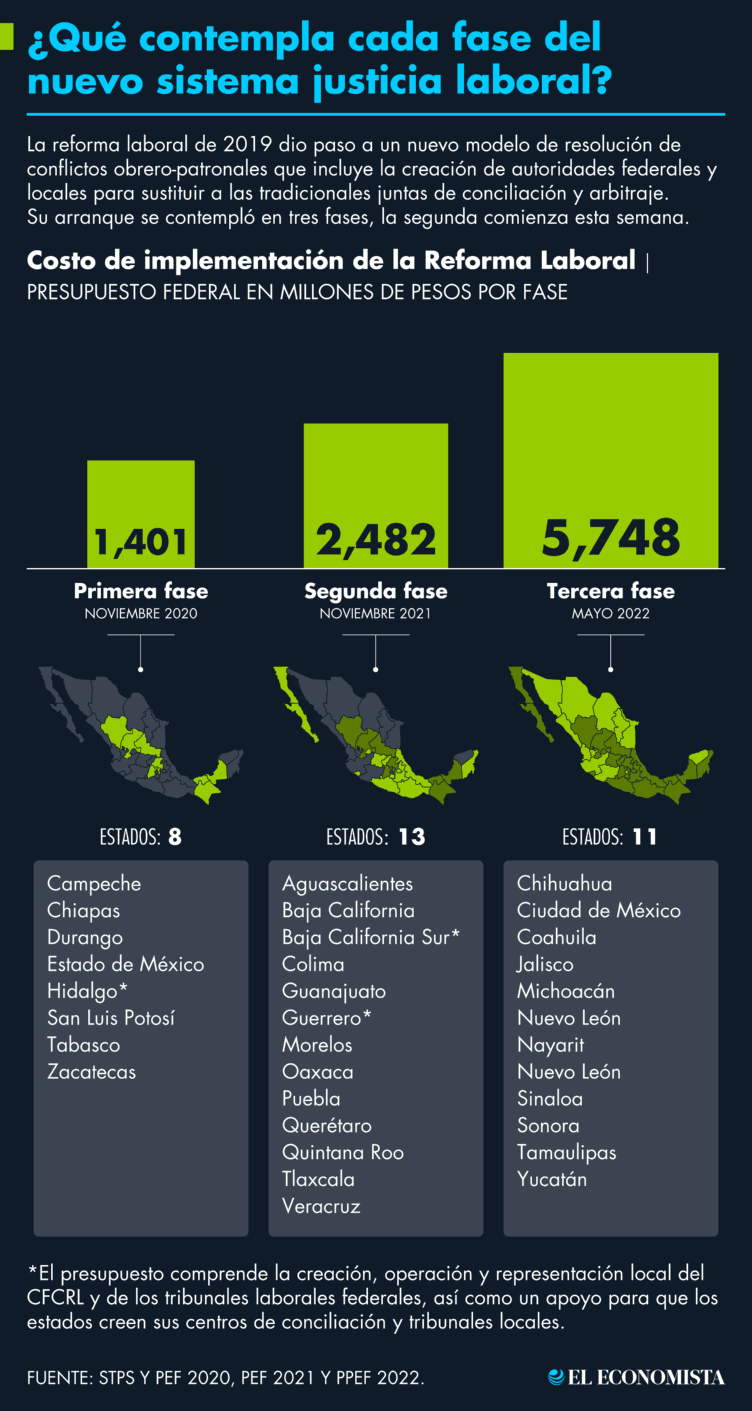The new model of labor justice lands this week in 13 additional states to consolidate its second phase of implementation. In this way, 63% of the national territory will have a conflict resolution mechanism based on conciliation and labor courts in charge of the Judicial Power.
The 2019 labor reform modified the justice system for the world of work with an important commitment to conciliation as a way to avoid the judicialization of conflicts and, consequently, the saturation of cases in the courts, as happened with the Conciliation and Arbitration boards, a a situation that triggered long trials and untimely resolutions.
“This gigantic challenge of changing not only the rules and the model, but the work culture In our country, both in the sphere of labor justice and in the field of union freedom and democracy, on this path we can today have the satisfaction of having tangible results in the implementation of the first stage ”, highlighted Luisa María Alcalde Luján, head of the Ministry of Labor and Social Welfare (STPS) during the National Meeting of Presidents of Special Boards.
The dispute resolution mechanism that seeks prompt and expeditious justice contemplated the creation of new authorities: the Federal Center for Labor Conciliation and Registration (CFCRL), federal labor courts in charge of the Judiciary, and conciliation centers and local courts.
Baja California, Baja California Sur, Aguascalientes, Guanajuato, Querétaro, Colima, Veracruz, Puebla, Tlaxcala, Morelos, Guerrero, Oaxaca and Quintana Roo are the states that will open the doors of the new model of labor justice from the November 3.
The challenge of implementing the 2019 labor reform rests, to a large extent, on the conciliation centersIn an interview, Liliana San Martín, head of the Secretary of Labor (ST) of Querétaro, one of the states that joins the implementation of the new justice model this year, maintains in an interview.
“In labor matters the figure of the media had been postponed alternate resolution. It was extremely necessary and today it is a part that we assume ”, he explains.
For the second phase, the Federal Government allocated 2,482 million pesos, which includes the operation of the CFCRL and its new local representations, the creation and operation of federal labor courts and the subsidy to support the entities in the installation of their centers of conciliation and courts.
Luisa María Alcalde highlighted that the bet on conciliation has yielded good results, since the 70% of the issues received has been resolved by this means in less than 45 days and the remaining 30% that has passed to the labor courts has been resolved in less than four months. The model promises to reduce the length of a trial from four years, on average, to eight months.
The third and final phase of implementation, which includes the addition of the 11 states remaining in 2022, it will cost 5,748 million pesos. It includes the following states: Chihuahua, Mexico City, Coahuila, Jalisco, Michoacán, Nayarit, Nuevo León, Sinaloa, Sonora, Tamaulipas and Yucatán.
The new labor justice system “It is without a doubt a watershed. We are committed to achieving resolutions within the legal framework that the worker must also bear in mind. But the conciliation centers will be guarantors that labor rights are respected ”, affirmed the Secretary of Labor of Querétaro.
Convergence and coexistence of models
Only in Querétaro, the conciliation and arbitration boards still have pending “around 37,000 trials”Liliana San Martín reported. That is why these bodies will continue to operate for between four and five more years due to the nature and backwardness of the cases in process, the state labor authority foresees.
However, in this entity in the center of the country, as in the rest of the states that make up the second stage of implementation, labor disputes that are reported as of November 3 will be resolved through a prejudicial conciliation, which will be a requirement to take a case to a labor court, except for some exceptional cases such as matters related to harassment or discrimination.
Liliana San Martín explained that 90% of the trials in the entity it is due to unjustified dismissals, a matter for which the conciliatory stage must be exhausted in order to initiate a lawsuit. “This information gives us a scenario of what kind of proposals we will receive” and the possible solutions, the official considered.
People who work in the states that join the new model of justice They should take into account that they will go to the Federal Conciliation Center or to the local conciliation centers depending on whether the industrial branch to which their employer belongs is federal or local.
The head of the ST of Querétaro affirmed that the conciliation centers They will have trained personnel according to the profile required by a model that is committed to dialogue between workers and employers. At least in their entity, they will have 14 conciliators and conciliators. Public servants who have been trained and certified. “It is a very specific profile,” he stressed.

Reference-www.eleconomista.com.mx